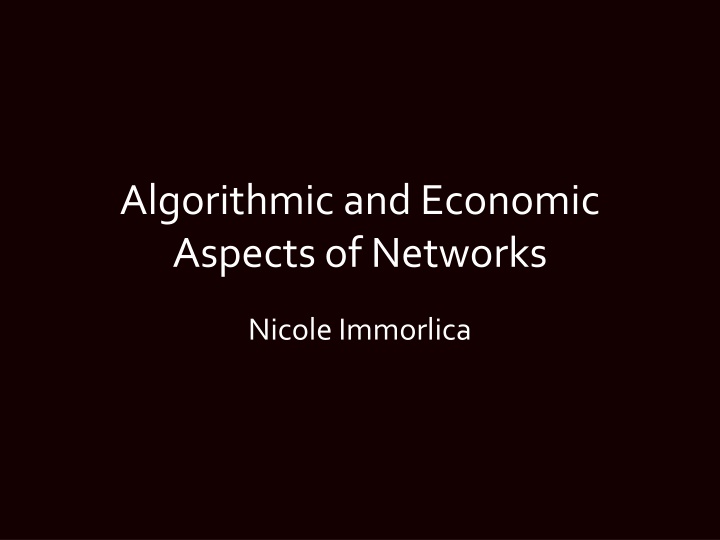
Insights into Algorithmic and Economic Aspects of Networks by Nicole Immorlica
Explore the networked markets, trust dynamics, labor markets, and information flow in the context of network theory. Delve into the significance of strong and weak ties, information dissemination, and the impact of network architecture on employment correlations.
Uploaded on | 2 Views
Download Presentation

Please find below an Image/Link to download the presentation.
The content on the website is provided AS IS for your information and personal use only. It may not be sold, licensed, or shared on other websites without obtaining consent from the author. If you encounter any issues during the download, it is possible that the publisher has removed the file from their server.
You are allowed to download the files provided on this website for personal or commercial use, subject to the condition that they are used lawfully. All files are the property of their respective owners.
The content on the website is provided AS IS for your information and personal use only. It may not be sold, licensed, or shared on other websites without obtaining consent from the author.
E N D
Presentation Transcript
Algorithmic and Economic Aspects of Networks Nicole Immorlica
Networked Markets Garmets Market Marseille Fish Market Labor Markets
Why Network Trust, predicability, referrals, incomplete contracts, friction, moral hazard/adverse selection price, reputation
Labor Markets better You hear about jobs through your friends. Granovetter
Boormans Model Network of strong and weak ties Preferential flow of information about job opennings through network
Strong and Weak Ties Weak Strong Weak + Strong = Time
Information Flow 1) People need jobs with prob. . 2) People hear about jobs with prob. . 3) People tell (stronger) friends about jobs.
Boormans Results Study trees, fix degree of strong/weak ties, consider equilibria via simulation 1) As cost of strong ties , # strong ties . 2) As unemployment prob. , # strong ties .
Whats Missing? network architecture, e.g., weak ties more likely to be bridges correlation in employment state over time and network structure
Carvo-Armengol & Jackson Drop strong/weak distinction, but incorporate time.
Information Flow 1) People need jobs with prob. . 2) People hear about jobs with prob. . 3) People tell friends about jobs.
Tarred with the Same Brush Time causes correlation in employment: you are more likely to find a job if more of your friends have jobs
Persistance of (Lack of) Luck The longer you are unemployed, the less likely you will find a job tomorrow: because you are more likely to have more unemployed neighbors
Education Agents can pay cost ci to be educated. educated apply previous model uneducated payoff zero
Poverty Traps Payoff: 0.5 ci Payoff: 0.6 ci Payoff: 0.65 ci Payoff: 0.69 ci
Networked Exchange Theory Network represents potential trades what prices result?
Nash Bargaining How to split a dollar? Matt ($0.50) Mykell ($0.50) If negotiations fail, you get nothing.
Nash Bargaining How to split a dollar? Trevor ($0.70) William ($0.30) If negotiations fail, Trevor gets $0.60, William gets $0.20.
Nash Bargaining Any division in which each agent gets at least the outside option is an equilibrium. Yet . agents usually agree to split the surplus.
Nash Bargaining If when negotiation fails, - A gets $a - B gets $b Then when succeed, - A gets $(a + s/2) - B gets $(b + s/2) s = (1 a b) is the surplus
Nash Bargaining Nash: Agents will agree to split the surplus. Motivated by axiomatic approach, optimization approach, and outcome of particular game- theoretic formulations.
Bargaining in Networks Value of outside option arises as result of network structure.
Bargaining in Networks Matt ($0) Bach ($0) Mykell ($0) William ($0.50) Transactions worth $1. Only one transaction per person! Arun ($0.50)
Bargaining in Networks Almost all the money.
Bargaining in Networks v v gets between 7/12 and 2/3 in negotiation to left.
Bargaining in Networks v v gets between 1/2 and 1 in negotiation to left.
Cook and Yamagishi A solution for a network G is a matching M and a set of values u for each node u s.t., - For (u,v) in M, u + v = 1 - For unmatched nodes u, u = 0
Stable Outcomes Node u could negotiate with unmatched neighbor v and get (1 - v). Outside option of u is u = maximum over unmatched neighbors v of (1 - v).
Stable Outcomes Defn. An outcome is stable if for all u, u u. Notice there are many stable outcomes, so which one should we expect to find?
Balanced Outcomes Each individual bargaining outcome should agree with the Nash bargaining solution. suv = 1 - u - v u = u + s/2 And similarly for v.
Computing Balanced Outcomes A balanced outcome exists if and only if a stable outcome exists. Balanced outcomes can be computed and characterized using Edmonds-Galai decompositions. [Kleinberg-Tardos STOC 08]
Assignment: Readings: Social and Economic Networks, Chapter 10 The two Kearns papers or a paper on labor markets of your choosing (see refs in book) Reaction to paper Presentation volunteers?
